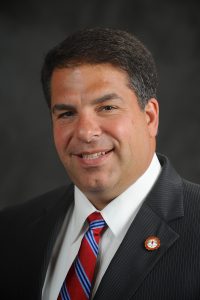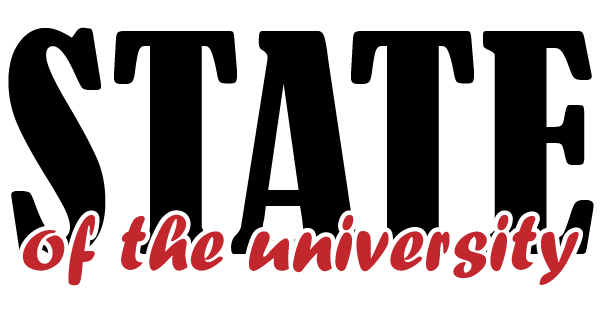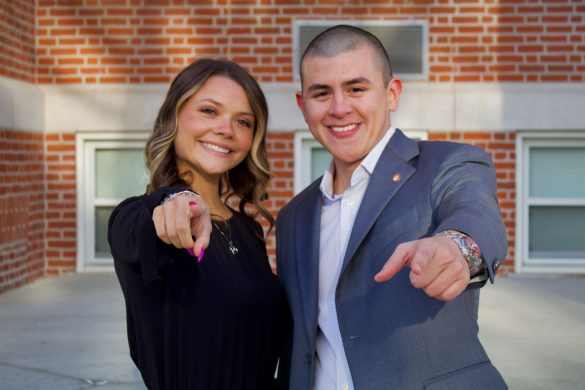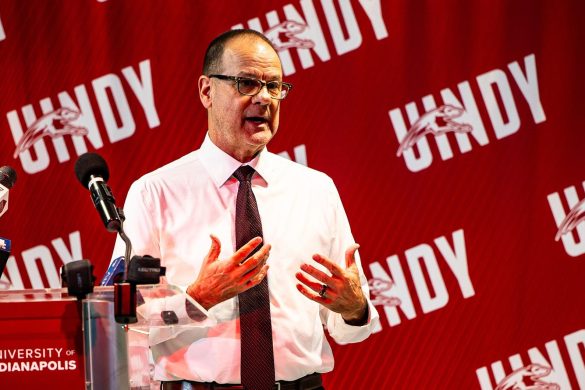Editor’s Note: This is the second, and final part, of a two-part series about the state of the University of Indianapolis. The first part was published on Feb. 24.
2020 was a year full of events that led to unprecedented changes to the lives of students, faculty and staff at University of Indianapolis. In 2021, UIndy is facing further changes in admissions and enrollment, growth in the R.B. Annis School of Engineering and is preparing to hold May commencement in-person, although in a unique way. University officials are also preparing for the future and are hopeful about what is to come.
Admissions and enrollment
The COVID-19 pandemic’s economic impacts have led to a drop in enrollment at many colleges and universities across the U.S., with overall enrollment nationwide dropping 2.5% for Fall 2020, according to InsideHigherEd.com. UIndy’s students were hit hard by the economic downturn, with some students unable to continue their education due to lack of income, according to University President Robert Manuel. This, however, was just one issue UIndy had to look at, Manuel said.
“‘How do we find institutional dollars to be able to help students continue their education if family units were unable to pay for them anymore?’ That’s a difficult set of questions when it’s a lot of money,” Manuel said. “If you’re a student at UIndy, you’re part of our family, and we try to figure out how to help each other to get you through while that [downturn] was happening.”

Manuel said that he has been impressed that the number of students re-registering for the second term of this academic year has not decreased. In fact, the number is exactly where UIndy had budgeted and expected, Manuel said.
Current students were not the only students affected by the pandemic. Incoming freshmen and potential students were also affected by the COVID-19 pandemic, which led to delays in decisions, Manuel said.
UIndy also is beginning to see that for the next freshmen class, the number of people who are applying, being accepted and depositing money to attend UIndy is above rates the university has seen in the last year and is very encouraging, Manuel said. As of Feb. 17, 7,292 people have sent completed undergraduate applications to UIndy, according to data provided by the university. Of those, 7,031 were accepted and 504 of those acceptances have made deposits, according to data provided by the university.
Compared to 2020, UIndy received 825 more completed applications, and the number of acceptances is up by 1,115, as of Feb. 17, according to data provided by the university. UIndy has received 43 fewer deposits, compared to 2020, according to data provided by the university. This drop is due to students taking a month longer, on average, to make their decision on where they would attend college, which is a nationwide trend that colleges are experiencing, according to university officials.
UIndy also saw a substantial increase in the number of total inquiries with 97,712 inquiries for Fall 2021, compared to 60,508 for Fall 2020 — a 38.1% jump, according to data provided by the university.
For next year’s freshman class, the class of 2025, the university will be waiving the SAT and ACT requirements once again, according to Manuel. The decision was the result of a vote by the Faculty Senate. Manuel said that the decision to waive the requirements raises questions about whether or not the SAT and ACT have any predictors on college GPAs.
“The quick reviews we’re doing [about the SAT and ACT] show that that’s not the case,” Manuel said. “The notion is ‘How do we choose and decide who’s going to be a UIndy student?’ Not knowing those doesn’t mean you don’t know who’s going to be able to fit and who’s going to be able to succeed. It’s just taking away one obstacle that people can take right now to the judge.”
School of Engineering’s growth
In January, the R.B. Annis School of Engineering began Phase 1 of its move into the new R.B. Annis Hall, located at 3750 Shelby St.. RBASoE, which launched in 2017, was initially funded by a $5 million gift from the R.B. Annis Educational Foundation, which led to the school being named after them, according to Manuel.
“We’ve known for a long time that STEM [science, technology, engineering and math] areas and engineering areas are needed, especially in our own backyard, for the economic development of our region,” Manuel said. “It was out of that, that we thought we should be starting an engineering program, and we put our very unique twist on it by combining the technology and the science with … the concept of design, and that has taken off in people’s minds. Companies that are looking for students are interested in not just whether they know the technology, but whether they know how to use it, to solve the problem that faces the company in question.”
This concept of design is UIndy’s DesignSpine curriculum. Manuel said that the creative way to teach engineering and engage engineering problems through this curriculum is what led to the development of the program, including the new building, faculty and machinery. The way the school is structured allows students to work with each other and faculty on all levels in creation and design, Mary Beth Bagg, interim vice president and provost, said.

RBASoE is also about to receive accreditation from the Accreditation Board of Engineering and Technology, or ABET, this fall. The accreditation process could not begin until the first class of students from RBASoE graduated, which was in May 2020, according to Bagg. The ABET accreditation would have begun last fall, but was delayed due to COVID-19, Bagg said.
“We would have been scheduled to do that already — to have the ABET visit — but because of COVID a lot of their accreditation visits and their process just got delayed,” Bagg said. “So we’ll do that this year, which is fine …. We’re working with it and we’ll get there.”
UIndy’s Vision 2030
When Manuel became UIndy’s ninth president in 2012, the university began formulating a vision for what UIndy would look like over the next several years. This formulation became Vision 2030, a set of lenses that UIndy was going to look through to focus on what the university wants to accomplish, Manuel said.
“We wanted to look through them so that we were thinking about institutional competitiveness and what we’re doing in our community and how we’d make brave decisions about being relevant to the future,” Manuel said. “We still look through those [today] at least for a while, until we redefine those a little bit later on. Every five years, we put together a five-year strategic plan, which tells us what we’re going to do that is informed by the lenses we looked through.”
The first five-year plan was from 2013-18 and focused on initiatives, according to university officials. Thirty-two initiatives were launched during this period, 20 of which were completed, six of which are still in progress, one of which is under review and five of which are dormant, according to university officials.
These initiatives include the building of the Health Pavillion, campus apartments and the renovations of Martin Hall and Krannert Memorial Library, according to university officials. The creation of the Professional Edge Center, the lacrosse programs, the Criminal Justice Education Lab, the Office of Equity and Inclusion and the development of an engineering program and a master’s of professional studies are also among the many initiatives launched during this period.
The second five-year plan, which began in 2019, will end in 2024, and will be followed by the final five-year plan of Vision 2030, according to university officials. The second plan is focused on the master planning process of professional life, campus and campus facilities, student life, academic life and finances, according to university officials. This phase was affected by the COVID-19 pandemic, Manuel said.
“In 2019, the [first] five years had ended, and we had started developing plans for the next five-year plan in support of Vision 2030. And then as Mary Beth [Bagg] said, ‘COVID happened,” Manuel said. “What we needed to do was take, now it’ll be two years off, of figuring out what the next five years looks like to make sure we can get through these two years of COVID and then move into the next five years’ strategic plan.”
Manuel said that he sees the university is beginning to be more successful at dealing with the pandemic, so now campus leaders are starting to think about what happens post-COVID-19 and what the next five-year plan would be like.
“That five-year plan will be our aspirational objectives that we want to accomplish in order to be able to be that relevant, prominent university,” Manuel said. “We want to be [an] impactful university. We want to be connected to the lenses that came out of [Vision] 2030.”
Campaign for the University of Indianapolis
Another aspect of Vision 2030 is the fundraising campaign the university began in its first five-year plan: the Campaign for the University of Indianapolis. According to Manuel, when UIndy began its first five-year plan, it began a comprehensive campaign where UIndy was looking to raise a certain amount of money to manage everything.
“Originally, we approved a $30, $35 million campaign, meaning we were hoping to raise $30 to $35 million,” Manuel said. “We became really successful early on. Now we’re imagining that we might end this campaign at $100 million dollars.”
Roughly $92 million has been raised for the campaign as of Feb. 5, according to Manuel. He said that UIndy has had a very good run of philanthropy over the last five years and that the university’s relationship with the donors and supporters has been made strong over the last five years. These relationships only grew stronger with the arrival of COVID-19, he said.
“People that could give, continue to give, did, and people that were unable to because they were affected by the financial circumstances remained within our community, and we did what we could for them at that time,” Manuel said. “We likely, within the next year, will close … this portion of the campaign .… I’m very, very grateful to the donors and the philanthropists who continued to support our work because they understand that our students getting their education is really one of the critical ways that we recovered from the harm that the COVID [disease] had on our economy.”
May commencement
Last year, COVID-19 forced the cancellation of an in-person commencement ceremony for May graduates. Flash forward to 2021, on Mar. 3, UIndy announced that there will be an in-person commencement parade the weekend of May 8. The parade will be for both the Class of 2021 and the Class of 2020, according to an email from the Commencement Planning Committee.
The parade will include a drive-through experience that will allow students to have friends or family in their car, according to the email. It will also include multiple chances to celebrate along the route, including live music, a DJ, a virtual photo booth and more, according to the email. At the end of the parade route, students will walk across the stage and receive their diplomas.
Several academic departments are also planning smaller events to celebrate the accomplishments of their graduates, according to the email. The goal of the parade is to allow students to commemorate their achievement with the people they care about while following safety guidelines, according to the email.
In February, Manuel said that there was a chance that commencement would look weird compared to years past. Manuel said the university would think as creatively as possible to provide as much normalcy to celebrate graduation.
“Our effort will be to make sure we do that as creatively and then safely as we can,” Manuel said. “If that means I got to dress up and come to your house and give you your diploma, I’m happy to do that, too.”
UIndy is in a ‘strong position’
UIndy is a very connected community that cares about each other a lot more than most, Manuel said. Because of this, the decisions the university has made were about the well-being of everyone, he said.
“They were about ‘How do we make sure we, as people — students included — are getting through the experience in the best way we can’ [and] as a result we were very, very creative,” Manuel said. “As a result, we are in a very, very strong position …. As a result, our students stayed enrolled. Our faculty continue to teach. Our administrators continue to do their work and academic progress can still be made.”
Manuel said that there has not been one day where he has looked at UIndy and thought that they were in trouble because the university community has come together to try to solve it. While it is his job to be optimistic, Manuel said his judgment has been clouded for the past year.
UIndy, however, has figured ways to get through the questions that could have harmed the university, Manuel said. As a result of this, students continue to come and new students are wanting to enroll, he said.
“As we begin to think about more interactive ways for us to get back to our sense of community, I think we’re going to see that relevance though,” Manuel said. “I am very, very optimistic about our future and actually excited about the long-term outcome for us over the next one to five to six years. We have a lot that we’re going to be able to accomplish.”









